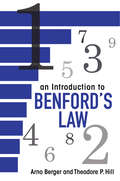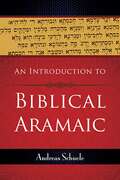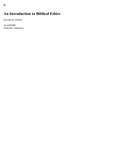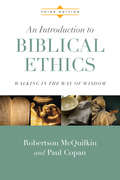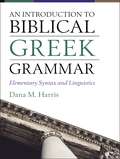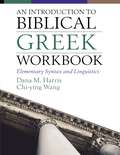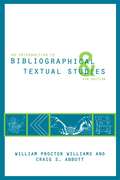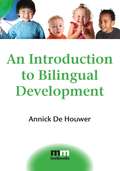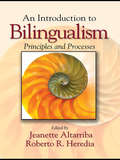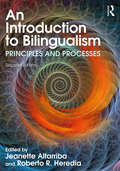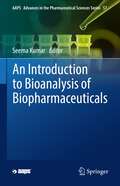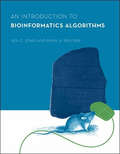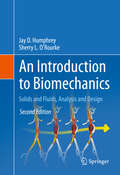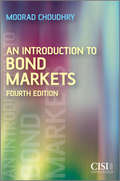- Table View
- List View
An Introduction to Benford's Law
by Theodore P. Hill Arno BergerThis book provides the first comprehensive treatment of Benford's law, the surprising logarithmic distribution of significant digits discovered in the late nineteenth century. Establishing the mathematical and statistical principles that underpin this intriguing phenomenon, the text combines up-to-date theoretical results with overviews of the law's colorful history, rapidly growing body of empirical evidence, and wide range of applications.An Introduction to Benford's Law begins with basic facts about significant digits, Benford functions, sequences, and random variables, including tools from the theory of uniform distribution. After introducing the scale-, base-, and sum-invariance characterizations of the law, the book develops the significant-digit properties of both deterministic and stochastic processes, such as iterations of functions, powers of matrices, differential equations, and products, powers, and mixtures of random variables. Two concluding chapters survey the finitely additive theory and the flourishing applications of Benford's law.Carefully selected diagrams, tables, and close to 150 examples illuminate the main concepts throughout. The text includes many open problems, in addition to dozens of new basic theorems and all the main references. A distinguishing feature is the emphasis on the surprising ubiquity and robustness of the significant-digit law. This text can serve as both a primary reference and a basis for seminars and courses.
An Introduction to Biblical Aramaic
by Andreas SchueleThe study of biblical Aramaic, an ancient Semitic language from which the Hebrew alphabet was derived, is necessary for understanding texts written during certain periods of early Jewish and Christian history and is especially important for the study of the books of Daniel and Ezra. This new textbook is a thorough guide to learning to read and translate biblical Aramaic and includes an introduction to the language, examples of texts for practice translations, and helpful comparison charts.<P> <P> Advisory: Bookshare has learned that this book offers only partial accessibility. We have kept it in the collection because it is useful for some of our members. To explore further access options with us, please contact us through the Book Quality link on the right sidebar. Benetech is actively working on projects to improve accessibility issues such as these.
An Introduction to Biblical Ethics: B&H Studies in Christian Ethics
by David W. Jones Daniel HeimbachThis book serves as an introduction to the field of biblical ethics, a subcategory of the discipline of moral theology. It differs from moral philosophy in that biblical ethics is distinctively Christian, and it is more specific than Christian ethics proper because it specifically focuses upon the application of the moral law -- as it is revealed in Scripture -- to daily living. <p><p>Introduction to Biblical Ethics explains the nature, relevancy, coherency, and structure of the moral law as revealed throughout the Bible. In addition to covering the foundational elements of biblical ethics, major issues investigated in this volume include: different types of law in Scripture, the relationship between the law and the gospel, and issues related to the prospect of conflicting moral absolutes. <p><p>Additionally, after a discussion of ethical methodology, and using the Ten Commandments as a moral rubric, author David W. Jones explores the place of the moral law in the lives of believers. In the final chapters, the events surrounding the giving of the Decalogue are surveyed, and the application of each of the Ten Commandments to Christian living is explored.
An Introduction to Biblical Ethics: Walking in the Way of Wisdom
by Paul Copan Robertson McQuilkinWhat should we do or not do? What attitudes, behavior and qualities are good? Can we be good without God? What is the highest good, the purpose of human existence? These are the questions the study of ethics seeks to answer. Unlike many approaches to ethics, this book foundationally turns to Scripture, going only as far as Scripture itself goes. The result is an overview of biblical ethics that not only addresses the life of love and wisdom to be lived out by Christians as virtuous individuals, but also as Christians in community, in society and in a world of God?s creation. Key preliminary considerations of love, law, sin and virtue are given their due in this thoroughly revised and updated text. The bulk of the work is then organized around the Ten Commandments and ethical themes springing from them—loving God (commandments 1-4) and loving others (commandments 6-10). This new edition includes added material on ethical alternatives such as relativism, social contract, utilitarianism and evolutionary ethics the seven deadly sins as well as the cardinal virtues vs. theological virtues end-of-life ethics, stem-cell research, animal rights, sexuality, genetics and technology, and other bioethical issues such as plastic surgery and surrogate motherhood technology and its depersonalizing effects as well as helping the poor the church?s engagement in society and how Christians can make a difference in the media. McQuilkin and Copan stay focused on how we are fulfilling the purposes of God for our lives—a will that is for our good and our well-being. This comprehensive study is the place to begin on the journey of living wisely, faithfully and obediently.
An Introduction to Biblical Ethics: Walking in the Way of Wisdom
by Paul Copan Robertson McQuilkinWhat should we do or not do? What attitudes, behavior and qualities are good? Can we be good without God? What is the highest good, the purpose of human existence? These are the questions the study of ethics seeks to answer. Unlike many approaches to ethics, this book foundationally turns to Scripture, going only as far as Scripture itself goes. The result is an overview of biblical ethics that not only addresses the life of love and wisdom to be lived out by Christians as virtuous individuals, but also as Christians in community, in society and in a world of God?s creation. Key preliminary considerations of love, law, sin and virtue are given their due in this thoroughly revised and updated text. The bulk of the work is then organized around the Ten Commandments and ethical themes springing from them―loving God (commandments 1-4) and loving others (commandments 6-10). This new edition includes added material on <P><P> <li>ethical alternatives such as relativism, social contract, utilitarianism and evolutionary ethics <li>the seven deadly sins as well as the cardinal virtues vs. theological virtues <li>end-of-life ethics, stem-cell research, animal rights, sexuality, genetics and technology, and other bioethical issues such as plastic surgery and surrogate motherhood <li>technology and its depersonalizing effects as well as helping the poor <li>the church's engagement in society and how Christians can make a difference in the media. <P><P>McQuilkin and Copan stay focused on how we are fulfilling the purposes of God for our lives―a will that is for our good and our well-being. This comprehensive study is the place to begin on the journey of living wisely, faithfully and obediently.
An Introduction to Biblical Greek Grammar: Elementary Syntax and Linguistics
by Dana M. HarrisAn Introduction to Biblical Greek Grammar focuses on the linguistic and syntactic elements of Koine Greek to equip learners for accurate interpretation. Drawing upon twenty years of Greek teaching experience and the latest developments in linguistics and syntax, Harris introduces students to basic linguistic concepts and categories necessary for grasping Greek in ways that are clear and intuitive. This solid foundation enables students first to internalize key concepts, then to apply and build upon them as more complex ideas are introduced.Several features are specifically designed to aid student's learning:Key concepts are graphically coded to offer visual reinforcement of explanations and to facilitate learning forms and identifying their functionsKey concepts are followed by numerous examples from the Greek New TestamentStudents learn how to mark Greek texts so that they can begin to "see" the syntax, identify the boundaries of syntactic units, and construct syntactic outlines as part of their preaching or teaching preparationFour integrative chapters, roughly corresponding to the midterms and final exams of a two-semester sequence, summarize material to date and reinforce key concepts. Here students are also introduced to exegetical and interpretive concepts and practices that they will need for subsequent Greek studies and beyond."Going Deeper" and "For the Curious" offer supplemental information for students interested in learning more or in moving to advanced language study.The accompanying workbook and video lectures (both sold separately) reinforce key concepts through additional contact with the material from each chapter of the grammar. All exercises in the workbook are taken from the Greek New Testament and the Septuagint and include extensive syntactical and exegetical notes to aid students.
An Introduction to Biblical Greek Workbook: Elementary Syntax and Linguistics
by Dana M. Harris Chi-ying WongThis workbook is designed to accompany An Introduction to Biblical Greek Grammar, which focuses on the linguistic and syntactic elements of Koine Greek to equip learners for accurate interpretation. It reinforces key concepts student learn through parsing and translation exercises for each chapter. All texts are taken from the Greek New Testament and the Septuagint and include extensive syntactical and exegetical notes to aid students.In An Introduction to Biblical Greek Grammar, author Dana Harris draws upon twenty years of Greek teaching experience and the latest developments in linguistics and syntax to introduce students to basic linguistic concepts and categories necessary for grasping Greek in ways that are clear and intuitive. This solid foundation enables students first to internalize key concepts, then to apply and build upon them as more complex ideas are introduced.Several features are specifically designed to aid student's learning:Key concepts are graphically coded to offer visual reinforcement of explanations and to facilitate learning forms and identifying their functionsKey concepts are followed by numerous examples from the Greek New TestamentStudents learn how to mark Greek texts so that they can begin to "see" the syntax, identify the boundaries of syntactic units, and construct syntactic outlines as part of their preaching or teaching preparationFour integrative chapters, roughly corresponding to the midterms and final exams of a two-semester sequence, summarize material to date and reinforce key concepts. Here students are also introduced to exegetical and interpretive concepts and practices that they will need for subsequent Greek studies and beyond."Going Deeper" and "For the Curious" offer supplemental information for students interested in learning more or in moving to advanced language study.
An Introduction to Biblical Law
by William S. MorrowInformed, accessible textbook on law collections in the Pentateuch In this book William Morrow surveys four major law collections in Exodus–Deuteronomy and shows how they each enabled the people of Israel to create and sustain a community of faith. Treating biblical law as dynamic systems of thought facilitating ancient Israel's efforts at self-definition, Morrow describes four different social contexts that gave rise to biblical law: (1) Israel at the holy mountain (the Ten Commandments); (2) Israel in the village assembly (Exodus 20:22–23:19); (3) Israel in the courts of the Lord (priestly and holiness rules in Exodus, Leviticus, and Numbers); and (4) Israel in the city (Deuteronomy). Including forthright discussion of such controversial subjects as slavery, revenge, gender inequality, religious intolerance, and contradictions between bodies of biblical law, Morrow's study will help students and other serious readers make sense out of texts in the Pentateuch that are often seen as obscure.
An Introduction to Biblical Law
by William S. MorrowInformed, accessible textbook on law collections in the Pentateuch In this book William Morrow surveys four major law collections in Exodus–Deuteronomy and shows how they each enabled the people of Israel to create and sustain a community of faith. Treating biblical law as dynamic systems of thought facilitating ancient Israel's efforts at self-definition, Morrow describes four different social contexts that gave rise to biblical law: (1) Israel at the holy mountain (the Ten Commandments); (2) Israel in the village assembly (Exodus 20:22–23:19); (3) Israel in the courts of the Lord (priestly and holiness rules in Exodus, Leviticus, and Numbers); and (4) Israel in the city (Deuteronomy). Including forthright discussion of such controversial subjects as slavery, revenge, gender inequality, religious intolerance, and contradictions between bodies of biblical law, Morrow's study will help students and other serious readers make sense out of texts in the Pentateuch that are often seen as obscure.
An Introduction to Bibliographical and Textual Studies
by William Proctor Williams Craig S. AbbottTo a reader of Joyce's Ulysses, it makes a difference whether one of Stephen Dedalus's first thoughts is "No mother" (as in the printed version) or "No, mother!" (as in the manuscript). The scholarship surrounding such textual differences--and why this discipline should concern readers and literary scholars alike--is the focus of William Proctor Williams and Craig S. Abbott's acclaimed handbook.This updated, fourth edition outlines the study of texts' composition, revision, physical embodiments, process of transmission, and manner of reception; describes how new technologies such as digital imaging and electronic tagging have changed the way we produce, read, preserve, and research texts; discusses why these matters are central to a historical understanding of literature; and shows how the insights, methods, and products of bibliographical and textual studies can be applied to other branches of scholarship.
An Introduction to Bibliographical and Textual Studies (Fourth Edition)
by William Proctor Williams Craig S. Abbott<p>To a reader of Joyce's Ulysses, it makes a difference whether one of Stephen Dedalus's first thoughts is "No mother" (as in the printed version) or "No, mother!" (as in the manuscript). The scholarship surrounding such textual differences--and why this discipline should concern readers and literary scholars alike--is the focus of William Proctor Williams and Craig S. Abbott's acclaimed handbook. <p>This updated, fourth edition outlines the study of texts' composition, revision, physical embodiments, process of transmission, and manner of reception; describes how new technologies such as digital imaging and electronic tagging have changed the way we produce, read, preserve, and research texts; discusses why these matters are central to a historical understanding of literature; and shows how the insights, methods, and products of bibliographical and textual studies can be applied to other branches of scholarship.</p>
An Introduction to Bilingual Development
by Annick De HouwerIncreasingly, children grow up hearing two languages from birth. This introductory textbook shows how children learn to understand and speak those languages against the backdrop of their language learning environments. A narrative around the bilingual development of four young children with different language profiles helps to explain the latest research findings in a lively and accessible manner. The narrative describes how bilingually raised children learn to understand and use sounds, words and sentences in two languages, and how they are able to use each of their languages in socially appropriate ways. Positive attitudes towards bilingual development from the people in bilingual children's environments and their recognition that child bilingualism is not monolingualism-times-two are the main ingredients ensuring that children grow up to be happy and expert speakers of two languages.
An Introduction to Bilingualism: Principles and Processes
by Jeanette Altarriba Roberto R. HerediaThis important text provides a general overview of the methods and theories used in the broad domain of bilingualism. The unique interdisciplinary approach, which is reflected in the various topics covered, gives students a global picture of the field. Topics range from early childhood intellectual development to educational and social-cognitive challenges to the maturing bilingual brain. Important developing areas such as cognitive aging, creativity, the social and cultural context perspective, communication disorders and sentence processing are also covered within the volume. This text is aimed towards undergraduate courses and graduate courses in psycholinguistics, especially those with an emphasis on bilingualism or second language learning.
An Introduction to Bilingualism: Principles and Processes
by Jeanette Altarriba and Roberto R. HerediaThe study of bilingualism and all of its aspects – from theory and models to social approaches and their practical applications – forms the cornerstone of the 2nd edition of this work. The chapters cover the latest advancements in the domains of psycholinguistics, neuroscience, creativity, and executive functioning. Contributions, new to this edition, offer the reader the most up-to-date research on lifespan and developmental issues. The work also provides insight into how human language is processed by all, not just by bilingual and multilingual speakers.This text is ideal for senior undergraduate and graduate courses in psycholinguistics and the psychology of language, especially those with an emphasis on bilingualism or second language learning.
An Introduction to Bioanalysis of Biopharmaceuticals (AAPS Advances in the Pharmaceutical Sciences Series #57)
by Seema KumarThe book provides a comprehensive review of the fundamental and practical aspects of bioanalytical support and the integral role it plays in the development of safe and efficacious biopharmaceutical drugs with speed and cost-effectiveness. The book focuses on a broad range of conventional and emerging biopharmaceutical modalities including monoclonal antibody-based therapeutics, gene therapy, cell therapy, peptides and oligonucleotides. The book starts with an introductory overview of bioanalysis showcasing the integral role it plays in understanding the drug disposition (pharmacokinetics/pharmacodynamics and immunogenicity) and the progression of bioanalytical strategy as the drug progresses through discovery and development stages of the program, taking into consideration the continually evolving regulatory landscape. The book further diversifies into individual biopharmaceutical modalities - monoclonal antibodies, antibody-drug conjugates, bispecifics, Fc-fusion proteins, gene therapies, cell therapies, peptides and oligonucleotides. The individual chapters focus on modality-specific bioanalytical assay strategies, critical reagents, assay formats, analytical platforms, associated bioanalytical challenges and mitigation strategies, industry best practices, and the latest understanding of regulatory guidance as applicable to the fast-growing biopharmaceutical landscape.
An Introduction to Bioinformatics Algorithms (Computational Molecular Biology)
by Neil C. Jones Pavel A. PevznerAn introductory text that emphasizes the underlying algorithmic ideas that are driving advances in bioinformatics.This introductory text offers a clear exposition of the algorithmic principles driving advances in bioinformatics. Accessible to students in both biology and computer science, it strikes a unique balance between rigorous mathematics and practical techniques, emphasizing the ideas underlying algorithms rather than offering a collection of apparently unrelated problems. The book introduces biological and algorithmic ideas together, linking issues in computer science to biology and thus capturing the interest of students in both subjects. It demonstrates that relatively few design techniques can be used to solve a large number of practical problems in biology, and presents this material intuitively. An Introduction to Bioinformatics Algorithms is one of the first books on bioinformatics that can be used by students at an undergraduate level. It includes a dual table of contents, organized by algorithmic idea and biological idea; discussions of biologically relevant problems, including a detailed problem formulation and one or more solutions for each; and brief biographical sketches of leading figures in the field. These interesting vignettes offer students a glimpse of the inspirations and motivations for real work in bioinformatics, making the concepts presented in the text more concrete and the techniques more approachable.PowerPoint presentations, practical bioinformatics problems, sample code, diagrams, demonstrations, and other materials can be found at the Author's website.
An Introduction to Biomaterials (Biomedical Engineering)
by Jeffrey O. HollingerA practical road map to the key families of biomaterials and their potential applications in clinical therapeutics, Introduction to Biomaterials, Second Edition follows the entire path of development from theory to lab to practical application. It highlights new biocompatibility issues, metrics, and statistics as well as new legislation for intelle
An Introduction to Biomechanics: Solids and Fluids, Analysis and Design
by Jay D. Humphrey Sherry L. O'RourkeThis book covers the fundamentals of biomechanics. Topics include bio solids, biofluids, stress, balance and equilibrium. Students are encouraged to contextualize principles and exercises within a "big picture" of biomechanics. This is an ideal book for undergraduate students with interests in biomedical engineering.
An Introduction to Biomechanics: Solids and Fluids, Analysis and Design
by Jay D. Humphrey Sherry L. O’RourkeThis textbook introduces the student to a consistent approach of formulating and solving problems involving the biomechanics of solids and fluids. Brief introductions are also provided for more complex situations that require methods of nonlinear elasticity, elastodynamics, viscoelasticity, or fluid-solid interactions. Concepts are motivated by concise descriptions of important biological, biomechanical, and clinical observations and techniques. Included are over 300 figures and 200 references, as well as complete derivations of the fundamental equations, solutions of over 100 example problems, and over 350 exercise problems. Perfect for a one- or two-semester introduction to biomechanics, this Third Edition includes expanded sections on complex fluid (non-Newtonian) and solid (nonlinear and anisotropic) behaviors as well as coupled problems for different tissues. Additional homework problems encourage the student to appreciate the broad applicability of the fundamental equations. An Introduction to Biomechanics, Third Edition is an ideal book for undergraduate students with interests in bioengineering, biomedical engineering, or biomechanical engineering, and serves as a valuable reference for graduate students, practicing engineers, and researchers. This book also: Guides students in developing intuitive understanding via a consistent consideration of diverse problems including cardiovascular, musculoskeletal, pulmonary, and cell mechanics Encourages students to develop a “big picture” approach to problem-solving in biomechanics through chapter summaries Challenges students to solve problems for conditions commonly experienced in the laboratory, industry, or the clinic
An Introduction to Biomedical Optics (Series in Optics and Optoelectronics)
by Robert Splinter Brett A. HooperMany universities now offer a course in biomedical optics, but lack a textbook specifically addressing the topic. Intended to fill this gap, An Introduction to Biomedical Optics is the first comprehensive, introductory text describing both diagnostic and therapeutic optical methods in medicine. It provides the fundamental background needed for grad
An Introduction to Biomedical Science in Professional and Clinical Practice
by Sarah Jane Pitt Jim CunninghamBiomedical Science in Professional and Clinical Practice is essential reading for all trainee biomedical scientists looking for an introduction to the biomedical science profession whether they are undergraduates following an accredited biomedical sciences BSc, graduate trainees or experienced staff with overseas qualifications. This book guides trainees through the subjects, which they need to understand to meet the standards required by the Health Professions Council for state registration. These include professional topics, laws and guidelines governing clinical pathology, basic laboratory techniques and an overview of each pathology discipline. It helps trainees at any stage of training and in any pathology discipline(s) to think creatively about how to gather evidence of their understanding and professional competence. By referring to specialist sources of information in each area, it helps students to explore particular topics in more depth and to keep up to date with professional and legal changes. It is also of value to any Training Officers who are looking for ideas while planning a programme of training for a trainee biomedical scientist. The book includes basic principles of working in the pathology laboratory including laws and regulations, which must be observed, such as health and safety, data protection and equal opportunities laws and guidelines. Practical exercises are included throughout the book with examples of coursework, suggestions for further exercises and self -assessment. Summary boxes of key facts are clearly set out in each chapter and ideas for group/tutorial discussions are also provided to enhance student understanding.
An Introduction to Bioreactor Hydrodynamics and Gas-Liquid Mass Transfer
by Enes Kadic Theodore J. HeindelReviews and compares the major types of bioreactors, defines their pros and cons, and identifies research needs and figures of merit that have yet to be addressedDescribes common modes of operation in bioreactorsCovers the three common bioreactor types, including stirred-tank bioreactors, bubble column bioreactors, and airlift bioreactorsDetails less common bioreactors types, including fixed bed bioreactors and novel bioreactor designsDiscusses advantages and disadvantages of each bioreactor and provides a procedure for optimal bioreactor selection based on current process needsReviews the problems of bioreactor selection globally while considering all bioreactor options rather than concentrating on one specific bioreactor type
An Introduction to Bond Graph Modeling with Applications
by J. A. Machado Vitor M. CunhaAn Introduction to Bond Graph Modeling with Applications presents a collection of exercises on dynamical systems, modeling and control for university students in the areas of engineering, physics and applied mathematics. We can find several books on bond graphs, but most merely a small set of exercises and, in a few cases, some commands for computer packages like MATLAB or Mathematica. It is difficult to find books with a broad set of solved exercises and proposed exercises with solutions, guiding researchers starting their work with bond graphs, or students who are just beginning their study of the topic. This book aims to fill that gap, and provide a comprehensive, reader-friendly introduction to the Bond Graph modeling tool. Features Gives in-depth theoretical background coupled with practical, hands-on instructions. Provides a clear pedagogical framework, with numerous exercises and problems. Suitable for students and researchers who work with bond graphs: principally such as applied mathematicians, physicist and engineers.
An Introduction to Bond Markets
by Moorad ChoudhryThe bond markets are a vital part of the world economy. The fourth edition of Professor Moorad Choudhry's benchmark reference text An Introduction to Bond Markets brings readers up to date with latest developments and market practice, including the impact of the financial crisis and issues of relevance for investors. This book offers a detailed yet accessible look at bond instruments, and is aimed specifically at newcomers to the market or those unfamiliar with modern fixed income products. The author capitalises on his wealth of experience in the fixed income markets to present this concise yet in-depth coverage of bonds and associated derivatives.Topics covered include:Bond pricing and yieldDuration and convexityEurobonds and convertible bondsStructured finance securitiesInterest-rate derivativesCredit derivativesRelative value tradingRelated topics such as the money markets and principles of risk management are also introduced as necessary background for students and practitioners. The book is essential reading for all those who require an introduction to the financial markets.
An Introduction to Bootstrap Methods with Applications to R
by Michael R. Chernick Robert A. LabuddeA comprehensive introduction to bootstrap methods in the R programming environment Bootstrap methods provide a powerful approach to statistical data analysis, as they have more general applications than standard parametric methods. An Introduction to Bootstrap Methods with Applications to R explores the practicality of this approach and successfully utilizes R to illustrate applications for the bootstrap and other resampling methods. This book provides a modern introduction to bootstrap methods for readers who do not have an extensive background in advanced mathematics. Emphasis throughout is on the use of bootstrap methods as an exploratory tool, including its value in variable selection and other modeling environments. The authors begin with a description of bootstrap methods and its relationship to other resampling methods, along with an overview of the wide variety of applications of the approach. Subsequent chapters offer coverage of improved confidence set estimation, estimation of error rates in discriminant analysis, and applications to a wide variety of hypothesis testing and estimation problems, including pharmaceutical, genomics, and economics. To inform readers on the limitations of the method, the book also exhibits counterexamples to the consistency of bootstrap methods. An introduction to R programming provides the needed preparation to work with the numerous exercises and applications presented throughout the book. A related website houses the book's R subroutines, and an extensive listing of references provides resources for further study. Discussing the topic at a remarkably practical and accessible level, An Introduction to Bootstrap Methods with Applications to R is an excellent book for introductory courses on bootstrap and resampling methods at the upper-undergraduate and graduate levels. It also serves as an insightful reference for practitioners working with data in engineering, medicine, and the social sciences who would like to acquire a basic understanding of bootstrap methods.
